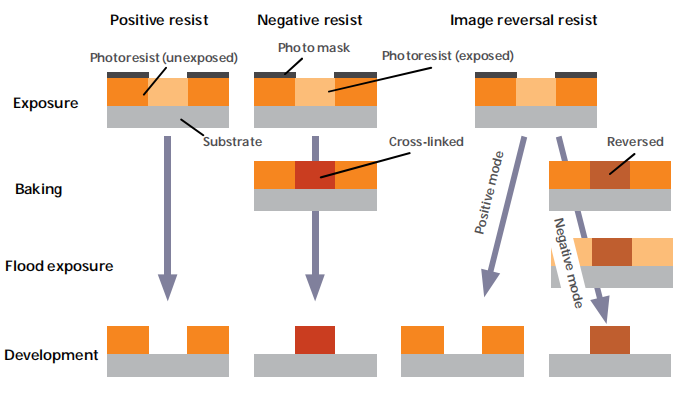Which Resist Mode?
Positive Resists
In the case of positive resists, exposed areas are soluble in the developer due to the formation of an indene-carboxylic acid taking place during exposure, while unexposed resist areas remain on the substrate. Since positive resists do not cross-link, exceeding their softening temperature (typically 100 - 130 °C) leads to a rounding of the resist profifiles, which is sometimes undesired, sometimes intentionally applied for certain applications (Reflflow).
Negative Resists
Negative resists such as the AZ® nLOF 2000 series or AZ® 15 nXT and AZ® 125 nXT are cross-linked at the exposed areas and remain there on the substrate after development, while the non-exposed areas are cleared. The cross-linking prevents a thermal softening of the resist profifiles.
Image Reversal Resists
Image reversal resists can either be processed positively or negatively. While in the positive mode, the process sequence is the same as for positive resists, the negative mode requires an image reversal bake step after exposure with subsequent flood exposure. Even in the negative mode, the degree of cross-linking of the resist is rather low, so the resist structures will soften beyond the softening point of typically 130°C.
Which Resist Coating Technique?
Spin-coating
Most AZ® and TI resists are optimised for spin-coating and allow smooth and very homogeneous film thicknesses of only a few hundred nm (AZ® 1505, ECI 3007, or 701 MiR) up to 100 μm with e. g. the positive AZ® 40 XT or negative AZ® 125 nXT, that can be set within limits via the spin profile.

Spray Coating
By means of spraying, highly textured substrates can be satisfactorily coated. For a homogeneous resist film thickness, a smooth resist surface and good edge coverage, an individually optimised composition of two or more solvents with varying vapour pressure is required, as they are present in appropriate spray resists such as the AZ® 4999 for optimised edge coverage or the TI spray for smooth resist films.
Dip Coating
Due to the high resist yield, the dip coating allows a very cost-effective coating for large, rectangular substrates up to the m2 range. For a homogeneous resist film thickness over the entire substrate, a certain solvent composition in the resist is required as realised in the MC Dip Coating Resist
